New Debt-To-Income Ratios: What You Need To Know

The Reserve Bank has indicated that the debt-to-income ratios they had been signalling will be introduced from 1 July 2024.
We’ve previously discussed debt-to-income ratios, but now that the Reserve Bank has confirmed what their regulations will look like, it’s timely to explore DTIs in greater detail!
So, what are they exactly and how might they impact the borrowing power of New Zealanders?
Let’s discover the answer to those questions now.
What Is A Debt-To-Income Ratio?
The debt-to-income ratio being introduced by the Reserve Bank is a financial metric used to assess the ability of borrowers to manage their debt repayments in relation to their income. It’s calculated using the following formula:
Total Debt ÷ Gross Income = DTI Ratio
That formula includes the following components:
- Total Debt: An individual’s total debt includes all their outstanding debts, such as mortgages, personal loans, car loans, and credit card debt.
- Gross Income: This refers to the borrower’s total pre-tax income from all sources.
- DTI Ratio: The score that is assigned to an individual to demonstrate their borrowing power.
In practical terms, if a borrower has total debts amounting to $500,000 and a gross annual income of $100,000, their DTI ratio would be 5 (or 500%).
Why Is A DTI Important?
The Reserve Bank believes that the debt-to-income ratio is a good indication of what a person is financially capable of borrowing. They feel it is a critical measure to help banks, financial institutions and other lenders determine the risk associated with lending.
Having a low debt-to-income ratio indicates that you are a relatively safe lending option as you should be able to maintain debt repayments in your current circumstances. However, having a high debt-to-income ratio could indicate that you are over-leveraged and may struggle to meet your repayment obligations if your income were to decrease or interest rates were to rise.
By setting limits on debt-to-income ratios, the Reserve Bank is aiming to curb risky lending practices. If they limit high DTI lending, then it is less likely borrowers will take on excessive debt, reducing the risk of defaulting during economic downturns. They also want to ensure house prices don’t blow out as high levels of mortgage debt can drive up house prices, creating bubbles in the property market.
New Zealand’s New Debt-To-Income Restrictions
On 1 July 2024, the new debt-to-income restrictions will come into effect. Banks will need to comply with the new restrictions from this date.
“The DTI restrictions will allow banks to make 20% of new owner-occupier lending to borrowers with a DTI ratio over 6 and 20% of new investor lending to borrowers with a DTI ratio over 7.
LVRs will be eased to allow banks to make 20% of owner-occupier lending to borrowers with an LVR greater than 80% and 5% of investor lending to borrowers with an LVR greater than 70%.
‘Having both the DTI and LVR restrictions in place means we can better focus them on the risks that they are designed for while achieving the same or better overall level of resilience in the financial system. Therefore, activating DTIs means that we can ease LVR settings too.’ Christian Hawkesby, Reserve Bank deputy, says.” [source]
What Does It Mean?
Under the new restrictions, the new debt-to-income restrictions mean that a bank or financial institution can lend up to six times an individual’s gross income (that’s the amount you make before tax is applied) for an owner-occupied property. For an investor, they are able to lend up to seven times the gross income.
There are some exceptions to that though, under the new rules banks are able to make 20% of their lending outside of those restrictions. So, they will have the discretion to assess on a case by case basis borrowers who are outside the standard DTI criteria.
In the current market, these changes are unlikely to have much impact as high interest rates are preventing people from taking large mortgages they can’t manage. But, when mortgage rates go down, debt-to-income ratios could potentially come into play more.
The biggest thing would be if house prices were to increase significantly compared to household incomes or if interest rates were to rapidly fall. At this stage, that is not predicted to happen. The Reserve Bank has indicated they don’t intend to drop the OCR until at least 2025 and house prices are expected to stay muted for the next little while.
Where To From Here?
We still find ourselves in uncertain times. While the introduction of DTIs might not have much impact in the short term, it doesn’t change the fact that no one is certain of what lies just around the corner!
We still don’t know when mortgage rates will go down and there was even talk in the last OCR review that the cash rate might even increase later in the year. The latest RBNZ forecasts don’t have the OCR falling until September 2025, which feels like a very long time away!
What can you do in the meantime?
Well, we know many families are feeling the economic squeeze right now, so we would strongly encourage anyone concerned about their current lending, looking to refix existing lending, or who wants to explore the potential of new borrowing to seek the expert advice of a mortgage specialist.
We would love the opportunity to help you decide the right path for your current financial situation and long-term goals. Chat with our friendly and experienced team today for honest and practical advice that you can trust.
